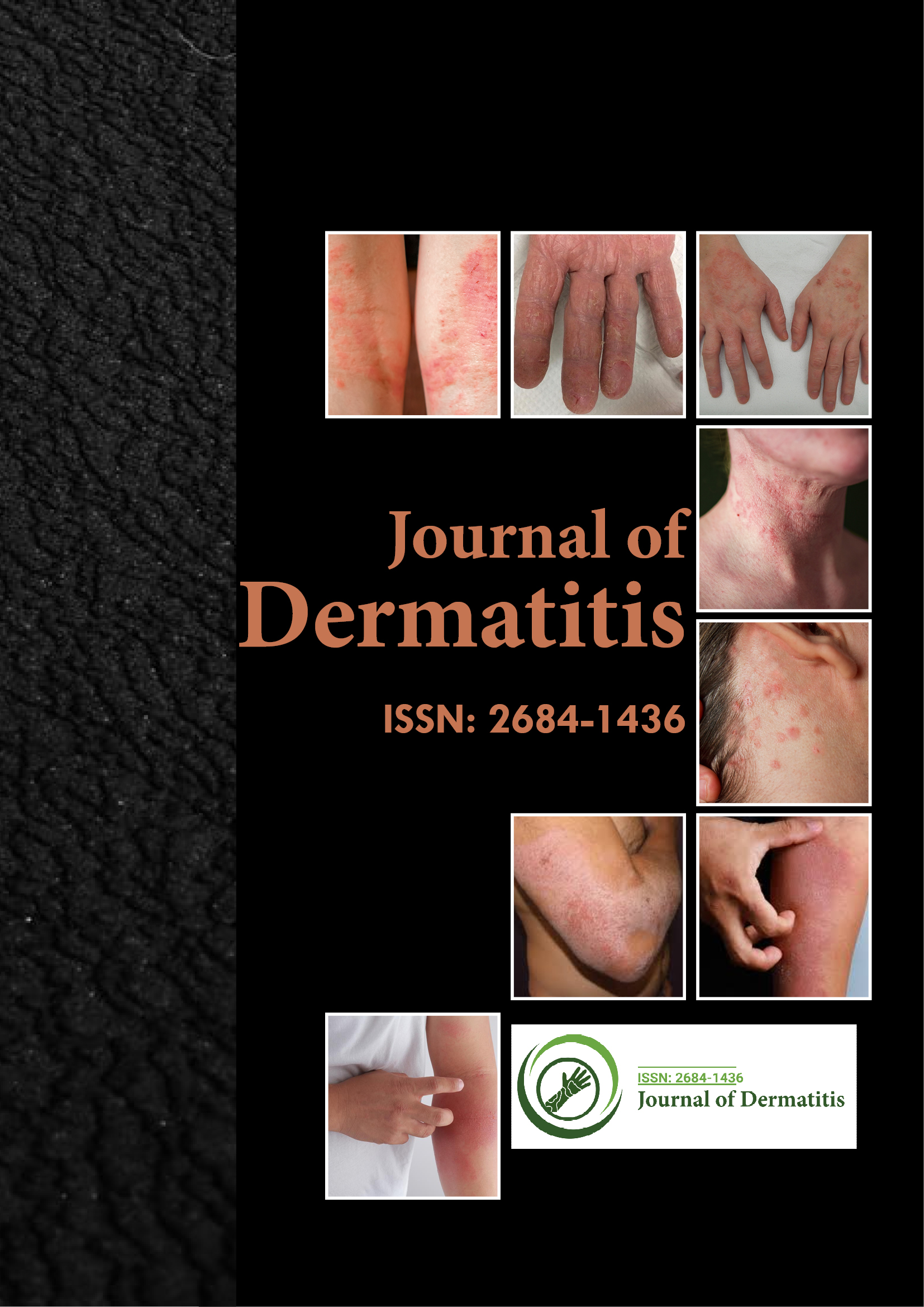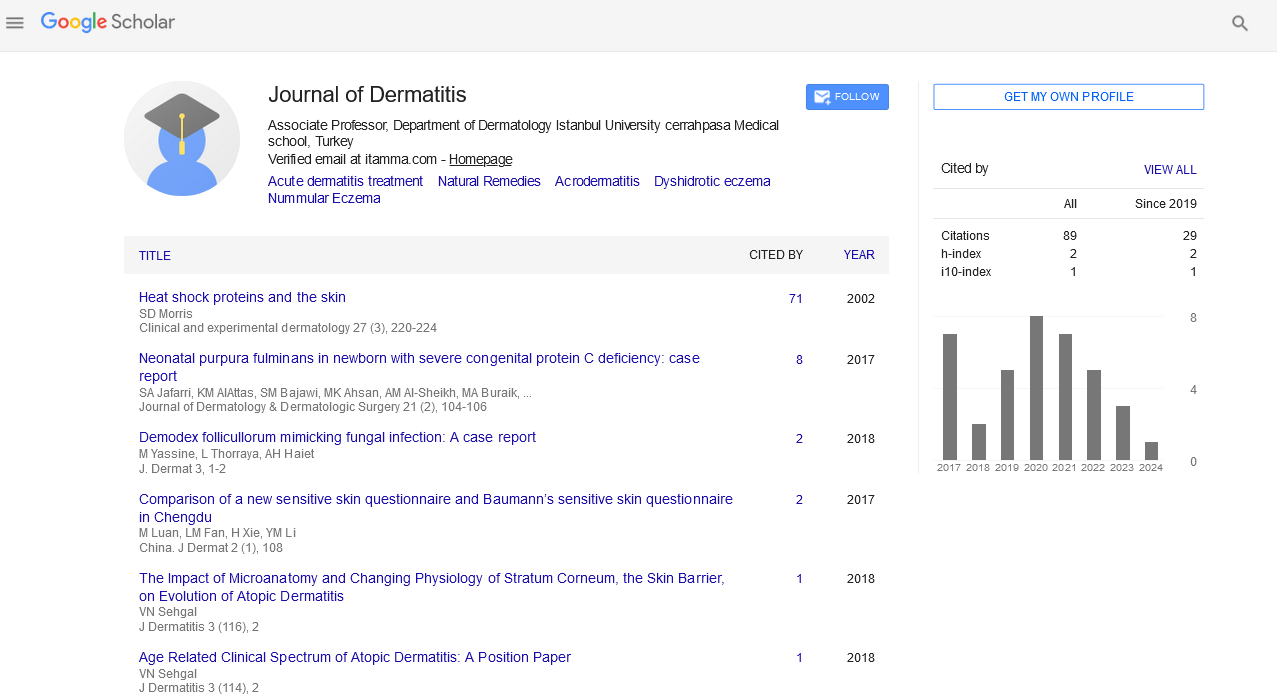Indexed In
- RefSeek
- Hamdard University
- EBSCO A-Z
- Euro Pub
- Google Scholar
Useful Links
Share This Page
Journal Flyer

Open Access Journals
- Agri and Aquaculture
- Biochemistry
- Bioinformatics & Systems Biology
- Business & Management
- Chemistry
- Clinical Sciences
- Engineering
- Food & Nutrition
- General Science
- Genetics & Molecular Biology
- Immunology & Microbiology
- Medical Sciences
- Neuroscience & Psychology
- Nursing & Health Care
- Pharmaceutical Sciences
Short Communication - (2025) Volume 10, Issue 2
Invisible Inflammation and Its Clinical Impact on Atopic Dermatitis Relapse Patterns
Rob Meier*Received: 25-Feb-2025, Manuscript No. JOD-25-29121; Editor assigned: 27-Feb-2025, Pre QC No. JOD-25-29121 (PQ); Reviewed: 13-Mar-2025, QC No. JOD-25-29121; Revised: 20-Mar-2025, Manuscript No. JOD-25-29121 (R); Published: 27-Mar-2025, DOI: 10.35248/2684-1436.25.10.279
Description
Atopic dermatitis affects individuals of all ages, particularly children and is characterized by pruritus, eczematous lesions and chronic relapsing episodes. Management typically involves topical anti-inflammatory therapies, moisturization and lifestyle adjustments. Conventional clinical endpoints focus on visible signs of remission; however, relapse after apparent recovery is common, prompting further investigation into underlying processes.
Subclinical inflammation refers to immune activity in the skin that persists even in areas that appear healthy. This phenomenon, often overlooked during routine evaluations, is gaining attention due to its potential role in initiating subsequent disease flares. Studies using advanced histological and molecular techniques have demonstrated that clinically unaffected skin in AD patients may still harbor active immune cells and elevated cytokine expression.
Clinical evidence of subclinical activity
Advances in non-invasive diagnostic tools such as tape stripping, confocal microscopy and skin biomarker analysis have facilitated the detection of subclinical inflammation.
Several longitudinal studies have observed that relapse often occurs at the same anatomical locations as previous lesions, supporting the concept of localized subclinical persistence. In one pediatric study, investigators monitored lesional and nonlesional skin post-treatment and found that areas with higher residual cytokine expression were significantly more likely to develop recurrent lesions within 8 weeks [1-3].
Implications for treatment strategies
Standard treatment regimens often target symptom resolution, leading to discontinuation of therapy once visible inflammation subsides. However, given the evidence of subclinical persistence, this approach may leave patients vulnerable to early relapse.
Several clinical trials have explored maintenance therapy using topical corticosteroids or calcineurin inhibitors. For instance, proactive therapy with twice-weekly topical tacrolimus in previously affected areas significantly reduced flare frequency and extended remission duration. These findings support the hypothesis that targeting residual inflammation even in visually clear skin may provide better long-term control [4-7].
Prevention of relapse
Understanding subclinical inflammation also informs patient education and self-management strategies. Patients often perceive disease control solely based on visible symptoms. Educating them about the possibility of ongoing immune activity may encourage adherence to maintenance therapies, even in the absence of active lesions.
Environmental modifications, moisturization and gentle skincare remain important in preserving skin integrity and minimizing flare triggers. Continued use of anti-inflammatory agents in high-risk areas during remission can be incorporated into individualized care plans [8-10].
Conclusion
Subclinical inflammation in atopic dermatitis represents an active component of disease pathophysiology that continues beyond visible recovery. The presence of immune activity in clinically normal skin underscores the need to move beyond symptom-based treatment paradigms. Incorporating detection methods for subclinical activity into routine practice may enable earlier intervention and reduce the incidence of relapse. Maintenance therapy, patient education and individualized care strategies informed by underlying inflammation can lead to more effective long-term disease control. Ongoing research will further clarify the mechanisms and implications of this hidden phase of AD and refine therapeutic approaches for sustained remission.
References
- Johnson H, Aquino MR, Snyder A, Collis RW, Franca K, Goldenberg A, et al. Prevalence of allergic contact dermatitis in children with and without atopic dermatitis: A multicenter retrospective case-control study. J Am Acad Dermatol. 2023;89(5):1007-1014.
- Labib A, Ju T, Yosipovitch G. Emerging treatments for itch in atopic dermatitis: A review. J Am Acad Dermatol. 2023;89(2):338-344.
- Guédon C, Tauber M, Linder C, Paul C, Shourick J. Real-life long-term efficacy of dupilumab in adults with moderate to severe atopic dermatitis: Results of a cohort study. Ann Dermatol Venereol. 2023;150,215-216.
- Port LR, Brunner PM. Management of atopic hand dermatitis. Dermatol Clin. 2024;42(4):619-623.
- Yu J, Milam EC. Comorbid scenarios in contact dermatitis: Atopic dermatitis, irritant dermatitis, and extremes of age. J Allergy Clin Immunol Pract. 2024;12(9):2243-2250.
- Strizzolo R, Seneschal J, Soria A, Staumont-Sallé D, Barbarot S, Viguier M, et al. Real-life management of atopic dermatitis patients with an inadequate response to on-label use of dupilumab. World Allergy Organ J. 2024;17(7):100923.
- Cassagne M, Galiacy S, Kychygina A, Chapotot E, Wallaert M, Vabres B, et al. Superficial Conjunctival Cells from Dupilumab-Treated Patients with Atopic Dermatitis with Ocular Adverse Events Display a Transcriptomic Psoriasis Signature. J Invest Dermatol. 2025;145(5):1050-1059.
- Bassani C, Pértile GL, Cunha SL, de Castro Wordell F, Cazarotto LF, Almeida AM, et al. Therapeutic efficacy and safety of topical ruxolitinib in mild-to-moderate atopic dermatitis: A systematic review. J Allergy Hypersens Dis. 2025:100032.
- Zeiger RS, Schatz M, Zhou B, Stern JA, Li Q, Basrai S, et al. Impact of Food Allergy on the Atopic March Progression from Atopic Dermatitis in Early Childhood to Other Atopic Disorders at School Age. J Allergy Clin Immunol Pract. 2025.
- Kamata M, Sun DI, Paller AS. Deciding which patients with atopic dermatitis to prioritize for biologics and Janus kinase inhibitors. J Allergy Clin Immunol Pract. 2025.
Citation: Meier R (2025). Invisible Inflammation and Its Clinical Impact on Atopic Dermatitis Relapse Patterns. J Dermatitis. 10:264.
Copyright: © 2025 Meier R. This is an open-access article distributed under the terms of the Creative Commons Attribution License, which permits unrestricted use, distribution, and reproduction in any medium, provided the original author and source are credited.

